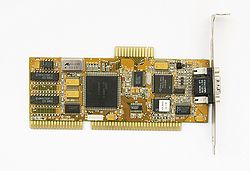MDA/CGA cards

ATI Graphics Solution Rev 3 (1986)
- Chipset: ATI CW16800-A
- Supports: Hercules Graphics Card mode and extended 132 × 25 / 132 × 44 text-modes on TTL monochrome monitors
- Supports: All CGA modes on both CGA/EGA and TTL monochrome monitors
- Switching between CGA and Hercules compatibility is done via supplied utility (
VSET.EXE) and doesn't require a reboot - Composite video output is available on an internal 3-pin connector (no support for colors, works only in the 40 × 25 text-mode or 320 × 200 graphics modes)
- Port: 8-bit PC/XT bus
- Source
- [5]
ATI Color Emulation Card (1986)
- Did at least support CGA graphics output to a TTL monochrome monitor [6]
ATI Graphics Solution Plus (1987)
- Chipset: ATI CW16800-B
- Supports CGA, Plantronics Colorplus CGA & Hercules Graphics Card graphics modes
- Compatible with MDA, CGA (and therefore also EGA displays), DIP switch selectable
- 64KB of DRAM
- Port: 8-bit PC/XT bus
- Source
- [7]
Graphics Solution Plus SP
- Chipset: ATI CW16800-B
- Adds Serial/Parallel Ports
Graphics Solution SR
- Chipset: ATI CW16800-B
- Uses static RAM

ATI Small Wonder Graphics Solution (1988)
- Chipset: ATI 18700
- Also known as Graphics Solution Single Chip or just GS-SC
- Single-chip version of the Graphics Solution plus
- 64KB of static RAM
- Composite output
Graphics Solution Single Chip or GS-SC with Game (1988)
- Includes a game port
- Lacks external composite video connector





